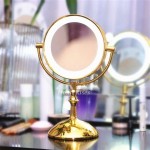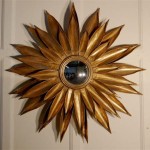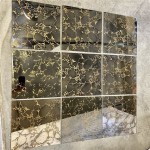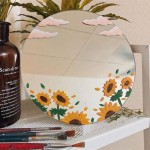Decorative Mirrors for the Dining Room
A decorative mirror can significantly enhance a dining room's aesthetic appeal and functionality. By reflecting light and creating an illusion of spaciousness, mirrors can transform the atmosphere of this important social space. Careful consideration of size, shape, frame, and placement ensures the mirror complements the existing décor and achieves the desired effect.
Choosing the Right Size and Shape
The size and shape of a mirror should be proportional to the dining room's dimensions and the surrounding furniture. A large mirror can make a small dining room appear larger, while a smaller, strategically placed mirror can highlight a particular feature. Round mirrors soften the lines of a room, while rectangular or square mirrors offer a more classic and structured look. Oval mirrors provide a balance between the two, adding a touch of elegance.
Frame Styles and Materials
The frame of a decorative mirror plays a crucial role in its overall style. Ornate, carved wooden frames lend a traditional or vintage feel. Simple, metal frames offer a more contemporary aesthetic. Frames made from natural materials like bamboo or rattan can create a bohemian or coastal vibe. The frame's color should complement the existing color scheme of the dining room, either blending seamlessly or providing a contrasting accent.
Placement Strategies for Maximum Impact
The placement of a mirror can dramatically influence its impact. Positioning a mirror opposite a window reflects natural light, brightening the room and creating a sense of airiness. Hanging a mirror above a sideboard or buffet can create a focal point and add a touch of elegance. Alternatively, a series of smaller mirrors can be arranged in a gallery wall to add visual interest and personality.
Reflecting Light and Enhancing Brightness
One of the primary benefits of using decorative mirrors in a dining room is their ability to enhance natural light. By strategically placing a mirror opposite a window or light source, the available light is reflected throughout the room, making it appear brighter and more inviting. This is particularly beneficial in dining rooms with limited natural light, creating a more welcoming atmosphere for meals and gatherings.
Creating an Illusion of Space
Mirrors can create an illusion of depth and spaciousness, making a dining room feel larger than it actually is. A large mirror on one wall can visually double the size of the room, while smaller mirrors can create pockets of visual expansion. This is particularly advantageous in smaller dining rooms or those with limited square footage, providing a more open and comfortable feel.
Complementing Existing Décor
The style of a decorative mirror should complement the existing décor and furniture in the dining room. A mirror with a similar style and finish to the dining table and chairs creates a cohesive and harmonious look. Conversely, a mirror with a contrasting style can serve as a statement piece and add a touch of visual interest. The overall goal is to create a balanced and aesthetically pleasing space.
Considering Maintenance and Care
Regular cleaning and maintenance are essential to preserving the beauty and longevity of a decorative mirror. Dusting the frame and glass regularly with a soft cloth prevents buildup and maintains clarity. Avoid using harsh chemicals or abrasive cleaners, as these can damage the frame and mirror surface. Proper care ensures the mirror remains a beautiful and functional element of the dining room for years to come.
Enhancing the Dining Experience
Beyond their aesthetic benefits, decorative mirrors can enhance the dining experience itself. The reflection of light and the increased sense of space create a brighter and more convivial atmosphere. The interplay of light and reflections can also add a sense of drama and elegance, making every meal feel more special.
Budgeting for a Decorative Mirror
Decorative mirrors are available in a wide range of prices, allowing individuals to find options that fit their budget. Factors that influence the cost include the size of the mirror, the frame material, and the intricacy of the design. Setting a budget beforehand helps narrow down the choices and ensures a suitable option is found without overspending.
Exploring Different Styles
From minimalist modern frames to ornate antique designs, the array of styles available allows for extensive customization. Exploring various design aesthetics, including Art Deco, Rustic, or Hollywood Regency, enables individuals to find a mirror that aligns with their personal taste and complements their existing dining room décor flawlessly.
:strip_icc()/dining-room-mirror-ideas-1-ashley-montgomery-b90b98cab74443e9ab4f9d5e9f6ac2d2.jpeg?strip=all)
17 Dining Room Mirror Ideas That Ll Dress Up Your Walls

Transform Your Dining Room With A Mirror Decoholic

How To Use Wall Sconces Design Tips Ideas Mirror Dining Room Decor Walls

Transform Your Dining Room With A Mirror Decoholic

Exquisite Wall Mirrors That Will Rock Your Dining Room Decor

Decorate Using Oversized Mirrors Mirror Dining Room Living Walls

Enhancing Interior Decor With Wall Mirrors Majestic Glass

5 Dining Room Mirrors A Must Have For Every Home

Transform Your Dining Room With A Mirror Decoholic

How To Decorate Your Home With Mirrors In Some Stunning Ways World Inside Pictures Mirror Dining Room Elegant Luxury








